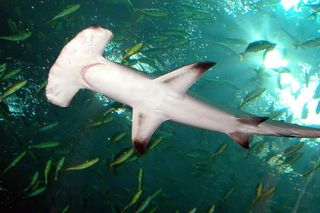
How Hammerhead Sharks Evolved

The ancestor of today's hammerhead sharks likely first appeared in Earth's oceans some 20 million years ago, and evolved over time into the variety of these funny-faced fish of all shapes and sizes that swim the seas today, a new study finds.
Sporting wide, flattened heads known as cephalofoils with eyeballs bulging at each end, hammerhead sharks are among the most recognizable fish in the world. These bizarre creatures range in length from about 3 to 18 feet (1 to 5.5 meters) and cruise warm waters around the world, from the Caribbean to Australia.
Scientists set out to study the evolutionary history of hammerheads by comparing the DNA of eight species from around the world to build family "gene trees" going back thousands to millions of generations and charting the splits that led to new species, particularly from the original large ancestor to smaller species.
"Our study indicates the big hammerheads probably evolved into smaller hammerheads, and that smaller hammerheads evolved independently twice," said study team member and evolutionary biologist Andrew Martin of the University of Colorado at Boulder.
The researchers suspect the hammerhead ancestor probably lived during the Miocene epoch about 20 million years ago.
The team found that the two lineages of small sharks (of about 3 to 4 feet in length) broke off of the main lineage at two separate times during history. One of the species, the winghead shark, now lives in the warm waters north of Australia and the other, the bonnethead shark, inhabits the Caribbean and tropical eastern Pacific Ocean.
The results of the new study are detailed in the May issue of the journal Molecular Phylogenetics and Evolution.
Sign up for the Live Science daily newsletter now
Get the world’s most fascinating discoveries delivered straight to your inbox.
Benefits of being small
One reason for the "incredible shrinking shark" over the eons may be the process of neoteny — the ability of some adult sharks to retain juvenile traits — or their ability to achieve sexual maturity at earlier ages, Martin said. "As the sharks became smaller, they may have begun investing more energy into reproductive activities instead of growth."
Smaller hammerheads also don't seem to get the same benefit from their odd noggins that their bigger cousins do. Cephalofoils appear to provide "lift" to large hammerheads as they cruise through the water — much like the wing of an airplane. Smaller hammerheads don't seem to get this same advantage, though they do get some other perks.
"It looks like they sacrifice locomotion advantages for prey detection and visualization," Martin said.
Another advantage hammerheads may gain from larger cephalofoils is an increased number of electrical sensors in their flattened noses and heads that can detect extremely weak electrical emissions from molecules associated with potential prey.
"Hammerheads appear to be able to triangulate on their prey, which is remarkable," Martin said.
Small sharks are highly variable in the size and shape of their cephalofoils, Martin said. The winghead shark, for example, has a laterally expanded head that is about half the size of its roughly 4-foot body length. At the other end of the spectrum is the bonnethead shark, about 3 feet long but which has the smallest cephalofoil of all hammerhead species — a protrusion that resembles the head of a shovel, Martin said.
Hammerheads in danger
Hammerheads are an ideal biological study subject in part because of some important similarities to humans, Martin said. Both have slow growth rates, mature late in life, give live birth and have relatively few offspring. While hammerheads may have a dozen or more pups, other oceanic fish regularly lay millions of eggs.
Hammerheads generally live for about 30 years, Martin said.
While hammerhead sharks appear intimidating, attacks on humans are extremely rare, said Martin. Hammerheads have relatively small mouths facing downward that are used to grab food like fish, shellfish, shrimp, squid, octopuses and stingrays.
"If you see a hammerhead, I'd say grab your camera and jump into the water," Martin said.
"Hammerheads are special fish, and there is nothing that remotely resembles them anywhere on the planet," he added.
Unfortunately, hammerheads — like most shark species — are on the decline. In addition to being overfished, sharks often are the victims of a technique known as finning, in which fishermen catch them, cut off their fins for use in delicacy soups, and return them to the water to die, Martin said. Shark meat also is used for fertilizer and to make pet food.
There currently are 233 shark species on the International Union for the Conservation of Nature's "Red List of Threatened Species," and 12 shark species are classified as critically endangered. A study led by Virginia Tech showed the great hammerhead, scalloped hammerhead and smooth hammerhead species declined by an average of 90 percent from 1981 to 2005.
"Their situation is generally pretty dire," Martin said.
- Dangers in the Deep: 10 Scariest Sea Creatures
- One the Brink: A Gallery of Wild Sharks
- Top 10 Deadliest Animals

